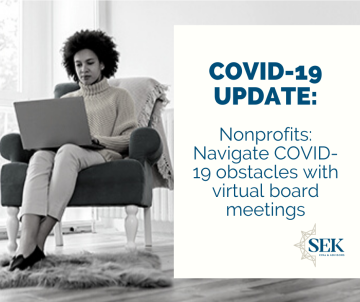Recent News & Blog / Nonprofits: Navigate COVID-19 obstacles with virtual board meetings

April 29, 2020
The novel coronavirus (COVID-19) pandemic has forced many of us to work differently — whether it’s isolated at home or in-person wearing facial masks and other protective gear. Even if your not-for-profit’s board of directors usually meets in person, current events strongly suggest the need for a Plan B. Here are some best practices for holding virtual board meetings.
Anticipate hurdles
With many board members under continued stay-at-home or quarantine orders, virtual meetings can enable more people to attend and your board to achieve a quorum. But before you set up a Zoom, WebEx or other online video meeting, check your state’s laws. Some states, for example, allow nonprofit boards to hold teleconferences but not video conferences. Your organization’s bylaws might also prohibit virtual meetings.
Even if your state’s laws and nonprofits’ bylaws give you the go-ahead, consider potential communication issues. For example, in teleconferences, participants won’t be able to read each other’s facial expressions and body language. Even in video conferences, board members may be unable to observe these cues as easily as they could in person — potentially leading to misunderstandings or conflicts.
In addition, the chair might find it difficult to shepherd discussion, especially if your board is bigger. Confidentiality is a concern, too. You must be able to trust that participants are alone and that their family members aren’t listening in to the conversation.
Get member buy-in
Don’t spring a virtual meeting on board members without first discussing with them the implications of such a change. Some board members may prefer to wait until stay-at-home orders are lifted and delay a meeting rather than conduct one remotely.
You’ll also need to ensure that all participants have the equipment they need. Test the system you’ve decided to use ahead of time and establish backup plans in the event of technological failures. Also, plan to send board members any supporting materials well in advance of your meeting and make them available online during the event.
Recognize that voting on any issue will need to be verbal and not anonymous, with each board member identifying himself or herself. Also, straightforward issues — such as updates from development staff or the formal approval of a policy — are better suited to virtual discussion than potentially controversial ones. Of course, given current circumstances, your board may have no choice but to consider emergency measures via tele- or video conference.
Lean on your board
Board members have likely already been in touch as your nonprofit confronts pandemic-related challenges. However you decide to hold board meetings, make sure you’re in constant touch with your directors and soliciting their advice when any difficult decisions need to be made.
© 2020